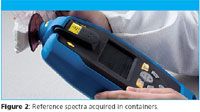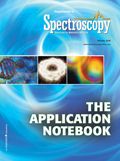Impact of Containers on Raw Material Verification Using a Handheld Raman Spectrometer
Raman spectroscopy is a well-accepted, powerful tool for material identification, and the ability of a Raman spectrometer to acquire spectra through plastic and glass packaging materials protects sample integrity and greatly reduces analysis time.
Raman spectroscopy is a well-accepted, powerful tool for material identification, and the ability of a Raman spectrometer to acquire spectra through plastic and glass packaging materials protects sample integrity and greatly reduces analysis time.

Figure 1
Experiment
A TruScan handheld Raman spectrometer from Ahura Scientific was used in this work. To verify sample identity, TruScan calculates a p-value, which is the probability that differences between the sample and reference spectra are due to the uncertainty of the measurement rather than to differences in molecular structure. If the p-value ≥ 0.05 a PASS result is displayed. For p-values < 0.05 a FAIL result is returned. A single reference spectrum for each material was acquired "neat," with no container wall between the sample and laser aperture of the spectrometer. Three measurements were made for each material and packaging combination listed in Figure 1.

Figure 2
Results
In Figure 1, green indicates p ≥ 0.1, well above the 0.05 PASS threshold. While results in the range of 0.05 < p-value < 0.1 (green with hash marks) are above the PASS threshold, there may be a higher probability of false-negative results. For those bottle containers, which produced false-negative results for powder materials, reference spectra were acquired through the bottles listed in Figure 2 and then re-tested. Figure 3 summarizes the results of Destructive Limit Testing (DLT) to determine how many layers of bags were required to produce a false-negative result.

Figure 3

Figure 4
Conclusions
The results demonstrate that most common packaging materials make a negligible contribution to the Raman spectra of materials contained within them. The strong Raman response for solvents makes their identity easy to verify regardless of packaging. For powdered materials, the effect of plastic bags on spectral properties was minimal, and with polyethylene, accurate identification could be obtained through up to 35 layers of bags for strong Raman scattering materials such as Titanium Dioxide. The Raman response of polystyrene, which prevented positive identification based on neat spectra, was effectively compensated by acquiring additional reference spectra through polystyrene containers. Thick-walled glass proved to be the most challenging due to variations in the luminescence profile between different glass thicknesses and suppliers that interfered with the spectra of weak Raman-scattering materials, even with a reference spectrum acquired through thick glass.

Ahura Scientific, Inc.
46 Jonspin Road • Wilmington, MA 01887
Tel. (978) 642-2549, Fax (978) 657-5921
www.ahurascientific.com • truscan@ahurascientific.com

Thermo Fisher Scientists Highlight the Latest Advances in Process Monitoring with Raman Spectroscopy
April 1st 2025In this exclusive Spectroscopy interview, John Richmond and Tom Dearing of Thermo Fisher Scientific discuss the company’s Raman technology and the latest trends for process monitoring across various applications.
A Seamless Trace Elemental Analysis Prescription for Quality Pharmaceuticals
March 31st 2025Quality assurance and quality control (QA/QC) are essential in pharmaceutical manufacturing to ensure compliance with standards like United States Pharmacopoeia <232> and ICH Q3D, as well as FDA regulations. Reliable and user-friendly testing solutions help QA/QC labs deliver precise trace elemental analyses while meeting throughput demands and data security requirements.